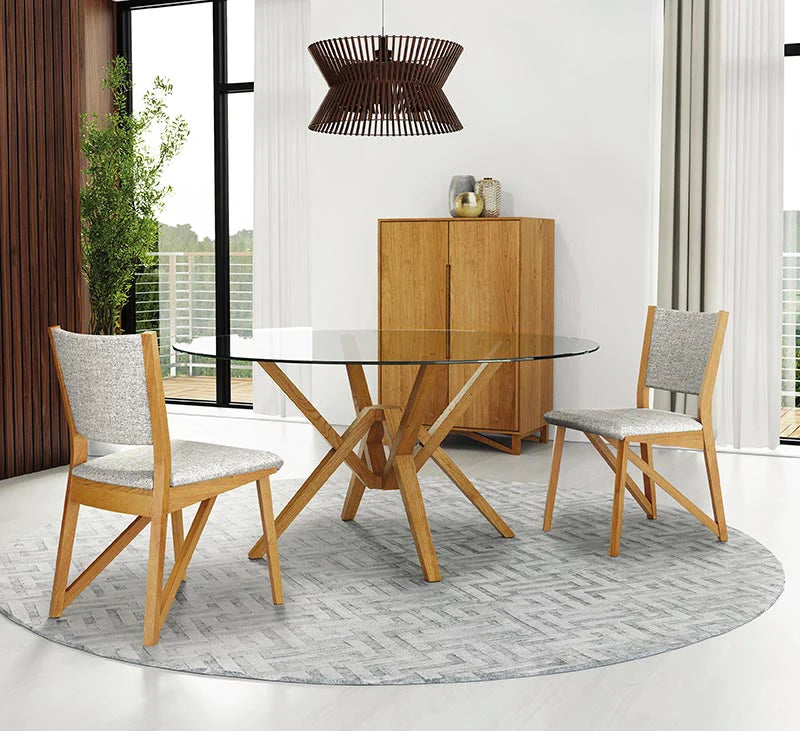When it comes to furnishing your dining room, one of the most important decisions you'll have to make is selecting the right dining table. In this guide, we'll explore everything you need to know about dining table seating capacity to ensure that you make the best choice for both your lifestyle and your space.
In this article, we’ll cover:
- Why is it Important to Know Your Tables Seating Capacity
- Common Dimensions & Seating Capacity by Table Shape
- Formal vs. Informal Dining: Impact on Seating Capacity
- How to Fit Extra Guests at the Table: Tips & Tricks
- Dining Table Seating Capacity: FAQs
Why is it Important to Know Your Table’s Seating Capacity?
Understanding your table's seating capacity is essential for both practical and aesthetic reasons. It determines how many people can comfortably dine without feeling cramped, while also influencing the overall flow and function of your dining area. Whether you're hosting a large gathering or enjoying a weeknight dinner with your family, the right table makes all the difference in your experience.
Choosing the right dining table involves more than just finding a style you like– it requires consideration of shape, size, and how they interact with your dining space. Here’s a more detailed look at making the best choice:
Consider the Room's Dimensions
Start by measuring your dining area. The table should fit comfortably while leaving enough room for movement around it. As a rule of thumb, there should be at least 36 to 42 inches of space between the table's edge and the walls– or any other piece of furniture. This allows for chairs to be pulled out easily and people to move around without feeling cramped.
Table Shape and Room Dynamics
- Rectangular Tables: Ideal for longer, narrower rooms. They maximize seating and are available in various lengths to suit different spaces.
- Round Tables: Best for small or square-shaped rooms. Round tables create a sense of intimacy and are great for facilitating conversation. They also lack sharp corners, making them a safer choice in homes with young children.
- Square Tables: Perfect for square dining areas or small breakfast nooks, square tables create a balanced look. Ideal for small groups and can be placed against a wall to save space in very small rooms.
- Oval Tables: Oval Tables combine the linear structure of rectangular tables with the lack of sharp corners found in round tables. They're suited for narrow or smaller rooms but offer more surface area (and seating) than the typical round table.
Consider the Size of Your Space
- For Small Spaces: Consider a drop leaf or extension table that can be modified according to your needs. A table that seats four as a standard but can expand to seat six is a great option.
- For Larger Spaces: Go for a table that fills the room well. A large room with a small table can feel unbalanced. Larger tables also offer more versatility for seating arrangements and table settings.
Assessing Your Needs
- Daily use vs. occasional entertaining: If you frequently host large dinners, opt for a larger table or one with extensions. For daily family use, a table that fits your immediate family comfortably while fitting well in the space is ideal.
- Seating capacity: Consider how many people you need to seat regularly and how many you might need to accommodate on special occasions. Always keep the balance between everyday practicality and the capacity for entertaining.
The Style Factor
While size and shape are predominantly about functionality, the style of your table should complement the style in the rest of the room. Whether you're leaning towards a sleek modern look, a farmhouse feel, or classic elegance, the table should fit in seamlessly with your decor. Also, consider the material of the table– wood, metal, glass, or a combination– as it contributes significantly to overall style and durability.
Common Dimensions & Seating Capacity By Table Shape
The shape of a dining table is not just a matter of style or preference, but it plays a crucial role in determining how many people can comfortably sit around it. Understanding the seating capacities associated with different table shapes helps in making an informed decision tailored to both your space and your social needs. Whether you have a cozy dining nook or a spacious dining room, here’s a guide to help you figure out the seating capacity for various table shapes:
Common Dimensions & Seating Capacity for Round Tables
Round tables are great for smaller spaces and create a sense of intimacy among diners . Here's a quick guide:
- 30” Round Table: Seats 2 comfortably.
- 36” Round Table: Seats 2-4 comfortably.
- 42" Round Table: Seats 4-5 comfortably.
- 48" Round Table: Seats 5-6 comfortably.
- 54" Round Table: Seats 6-7 comfortably.
- 60" Round Table: Seats 7-8 comfortably.
- 72" Round Table: Seats 8-10 comfortably.
Common Dimensions & Seating Capacity for Rectangular Tables
Rectangular tables are the most common and versatile dining table shape. They work well in most rooms:
- 42" Round Table: Seats 4-5 comfortably.
- 48" Round Table: Seats 5-6 comfortably.
- 54" Round Table: Seats 6-7 comfortably.
- 30" x 72" Rectangular Table: Seats 6-8 comfortably.
- 30" x 96" Rectangular Table: Seats 8-10 comfortably.
Common Dimensions & Seating Capacity for Oval Tables
Oval tables combine the space-efficient shape of round tables with the capacity of rectangular ones. They're perfect for narrow or smaller rooms:
- 60” Long Oval Table: Seats 5-6 comfortably.
- 72" Long Oval Table: Seats 6-8 comfortably.
- 84"-96" Long Oval Table: Seats 8-10 comfortably.
- 108"-120" Long Oval Table: Seats 10-12 comfortably.
Common Dimensions & Seating Capacity for Square Tables
Square tables are ideal for square-shaped rooms and smaller groups:
- 24" x 24" Square Table: Seats 2 comfortably.
- 30" x 72" Square Table: Seats 4 comfortably.
- 36" x 36" Square Table: Seats 4 comfortably.
Formal vs. Informal Dining: Impact on Seating Capacity
The choice between formal and informal dining styles has a significant impact on how many people you can accommodate at your table. Each style brings with it different considerations for space, seating arrangements, and table dimensions.
Formal Dining
In formal dining settings, the emphasis is often on an atmosphere that’s more formal. This approach affects seating capacity in several ways:
- Larger Table Sizes: Formal dining rooms typically house larger tables designed to accommodate more guests, ideal for hosting elaborate dinners and events.
- Spacious Seating Arrangements: Formal settings prioritize comfort and space for each guest. Chairs are often larger and have armrests, requiring more space per person.
- Less Flexibility for Additional Seating: In formal dining, there is usually a preference for maintaining symmetry and visual balance. Adding extra chairs or squeezing in more guests can disrupt the aesthetic and structured feel of the setup.
Informal Dining
Informal dining, on the other hand, is geared towards practicality and adaptability. This can impact the seating capacity in the following ways:
- Smaller and More Versatile Tables: Informal dining areas often feature smaller tables, suitable for daily meals with your immediate family. However, many of these tables are extendable or include leaves, allowing for extra seating when needed.
- Compact Seating Options: Chairs in informal settings tend to be smaller and without armrests, allowing more people to fit around the table.
- Creative Seating Solutions: Informal dining areas are more adaptable to adding extra seats for guests, using mixed seating options like stools or temporary chairs to increase capacity at casual gatherings.
How to Fit Extra Guests at the Table: Tips & Tricks
Sometimes you need to squeeze in a few more guests than your table can accommodate. If you find yourself in this situation, keep the following tips and tricks in mind:
- Use bench seating: Benches can accommodate more people than individual chairs and can be tucked under the table when not in use.
- Add a leaf: Extendable tables
- Use smaller chairs: Swapping out bulkier chairs for more compact options frees up space for more guests. In a pinch, stools create excellent additional seating.
Dining Table Seating Capacity: FAQs
Q: What’s the ideal distance between the table and walls or other furniture?
A: Aim for at least 36 inches of clearance to ensure comfortable movement around the table.
Q: How much space should each person have at the table?
A: Each diner should have about 24 inches of table space for comfort.
Q: Can round tables fit more people than square or rectangular tables?
A: Generally, round tables can accommodate more people in less space compared to square or rectangular tables of a similar size.
Q: Are extendable tables a good option for small spaces?
A: Yes, extendable tables offer flexibility. They can be compact for daily use and expanded for special occasions.
Q: How does seating capacity change with chair size?
A: Larger, bulkier chairs will reduce the number of people you can fit around a table. Opting for slimmer chairs can increase seating capacity.


